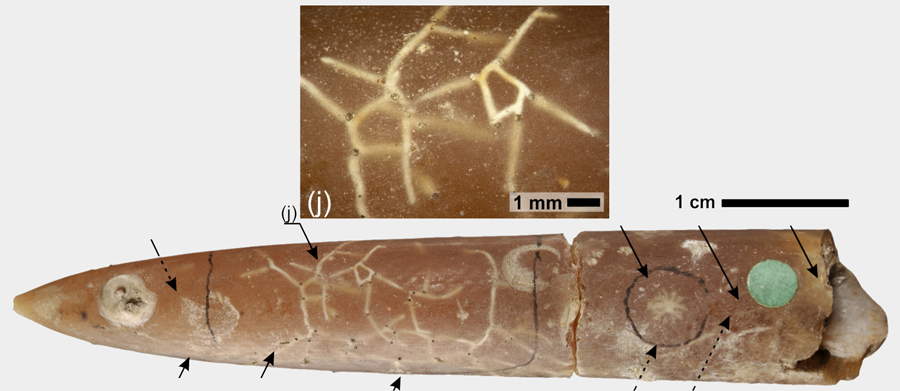Phoronida: Fossils updated on 13 February 2023 |
||
|
The origin of the Phoronida, certainly monophyletic with the other Lophophorata, goes back to approximately 800-1000 MA. Though as fossils, the phoronids are known since the Devonian (the brachiopods from the Cambrian and the bryozoans from the Ordovician): they have preserved the ancestral form and life way, nearly to those of the predecessor protolophophorate (Emig, 1984). Several authors suggested that tubes or tubicolous burrows in fossil records, described under various ichnogenera, i.e. Skolithos, Talpina, Diorygma..., belong to Phoronida (Fenton & Fenton, 1934; Avnimelech, 1955; Josey, 1959; Voigt, 1972; Mackinnon and Biernat, 1970; Sokoloski, 2005; Wisshak et al., 2017). Recently, Voigt (1975) has proved the identity of Phoronis species with the ichnogenus Talpina von Hagenow, 1840, confirmed in 1978. He also demonstrated (Voigt, 1972) that Conchotrema Teichert 1945 is a junior synonym of Talpina, as was confirmed by Plewes (1996). Talpina is abundant today and is well known from the Cretaceous (Voigt, 1972) and Jurassic (Fürsich et al., 1994). The ichnogenus ranges back to the Late Devonian (Thomas, 1911; Rodriguez & Gutschick, 1970; see Bromley, 2004). The fossil phoronid burrows seem to have been present since Devonian times (see Emig, 1982). The Talpina burrowed in such diverse calcareous substrata as calcareous algae, echinids, mollusc shells and rostra of Belemnites. Voigt gives criteria used for the discrimination of the phoronid burrows from other similar ones such as those of Thallophytes, sponges, Bryozoa or "worms". The frequent presence of agglutinating Foraminifera surrounding the opening the tube of a worm-like fossil animal provisionally determined as Phoronopsis and suggesting commensalisms between both fossil organisms (Voigt, 1970) in Upper Maastrichtian, has never been confirmed in recent observations on Phoronida. Tubes of the ichnogenus Talpina ramosa which occur frequently within the guards of Belemnella and Belemnitella (cf. Voigt, 1972; Wisshak et al., 2017) are described within the cavities probably originating from diagenetically destroyed aragonitic corals of the Maastrichtian chalk-tuff (Voigt, 1978). Towe (1978) and Larsson (1979) raised the possibility that Tentaculites were related to the brachiopods or perhaps more closely to the phoronids. However, the later author noted that the lophophorate feeding system of phoronids is incompatible with the planktonic mode of life proposed for some tentaculitids. Vinn (2005) and Vinn & Mutvei (2005) hypothesized that phoronids were perhaps the closest living relatives of Cornulites and Tentaculites, but also the brachiopods or the bryozoans (Vinn & Isakar, 2007). Nevertheless, to reconstruct cornulitids as 'skeletal phoronids' is entirely speculative. The only two groups with which Cornulites can be compared directly are bryozoans, and cnidarians with which comparable morphologies and shell structures are found (Herringshaw et al., 2007). Iotuba chengjiangensis, a form known from three speciemens from the Lower Cambrian Chengjiang fauna of China, has been interpreted by Chen & Zhou (1997) as a phoronid, having a U-shaped gut and is tentaculated. In the same fauna, another soft-bodied fossil has been claimed to be phoronid, Eophoronis, by Chen (2004). But the affinities of these fossils have been questioned (Cohen & Weydmann, 2005), and according to Conway Morris (2006) and Huang (2006), they may be priapulids. And Zhang et al. (2023) stated these orignal descriptions as nomina nuda according to art. 13.1 of the Code because they were not accompanied by a formal diagnosis; accordingly, they define a new genus and species under Iotuba chengjiangensis which exhibit features of flabelligeroid annelids, instead affinities with Lophophorata, and Phoronida in particular.
Skolithos linearis Haldeman, 1840 the type species of the ichnogenus, has been redescribed by Knaust et al. (2018) from Cambrian: the potential provider of the tube would be a polychaete annelid or a phoronid. Nevertheless, the tubes on figs. 11 and 12 of these authors can not be attributed to Phoronida, because its posterior part is rounded and closed, while, in phoronids, it is conical and shows always a small terminal opening: this detail is often ignored and yet primordial in phoronid tubes (Pourreau, 1979). There is a tendency in the recent work to attribute ichno-tubes to fossil phoronid (see recent references) without any comparison the real structure and chemical composition of the characteristic tube of the Phoronida. Moreover, it seems curious to propose a phyletic tree base upon ichno-tubes hypothetically attributed to Phoronida (see Skovsted et al., 2008). A short review has been proposed by Emig (2010), see also "Trace fossils refered by phoronids."
According to these authors, the mean age for the divergence along the Brachiopoda between the Linguliformea and Rhynchonel-liformea is 547 Ma, while that between brachiopods and phoronids is at 578 Ma. The tube-worms generally identified as Spirorbis range from Ordovician to Recent, often profusely encrusting shells and other substrates. Whereas Recent Spirorbis is a polychaete annelid, Taylor & Vinn (2006) consider that details of tube structure in pre-Cretaceous ‘Spirorbis’ are related to Microconchida. Nervertheless, this later extinct order is a highly hypothetical lophophorate group with a spirorbiform microchonchid tube. Such a tube can be related to Phoronida or to a phoronid-like… on the basis of the specific phoronid tube structure and rectilign shape (see below; and References). Reminder: the phoronid tube is so characteristic that it cannot be confused with any other tube. But this means one must have already seen and touched such tubes, not on a picture. About its fossilization, the question remains under debate, because taphonomy seems only possible under special conditions - see the case of lingulide valves (Brachiopoda) (see Emig, 1990). More... |
||
|
|

